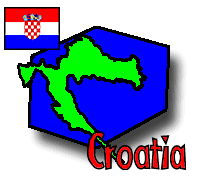Person of the Day: Josip Broz Tito
Place of the Day: walls of Dubrovnik
Tech Fact of the Day: sobe
Group Dispatch, April 12

Questions? Ask Anthony ![]() !
!
Return to Fast Facts
 |
 |
 |
 |
 |
|
Itinerary/ Journal |
Discussions |
About Croatia |
eDscape Projects |
Scrapbook |
|
|
|
|
|
|
|
Copyright 1997-99 BikeAbout. All rights reserved.
